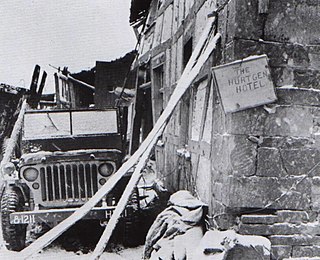
The Battle of Hürtgen Forest was a series of battles fought from 19 September to 16 December 1944, between American and German forces on the Western Front during World War II, in the Hürtgen Forest, a 140 km2 (54 sq mi) area about 5 km (3.1 mi) east of the Belgian–German border. Lasting 88 days, it was the longest battle on German ground during World War II and is the second longest single battle the U.S. Army has ever fought after the four-day-longer Battle of Bataan.
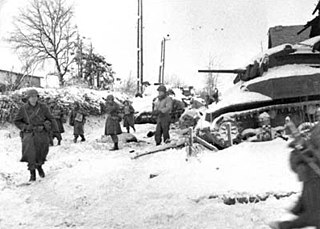
The Battle of the Bulge, also known as the Ardennes Offensive, was the last major German offensive campaign on the Western Front during the Second World War which took place from 16 December 1944 to 25 January 1945. It was launched through the densely forested Ardennes region between Belgium and Luxembourg. The offensive was intended to stop Allied use of the Belgian port of Antwerp and to split the Allied lines, allowing the Germans to encircle and destroy each of the four Allied armies and force the western Allies to negotiate a peace treaty in the Axis powers' favour.
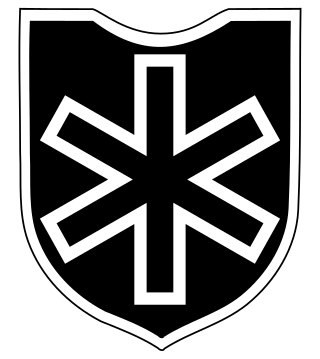
The 6th SS Mountain Division Nord was a World War II mountain infantry division of the Waffen-SS, the military wing of the German Nazi Party, primarily consisting of ethnic Germans along with some Norwegian and Swiss volunteers. It was the only Waffen-SS division to operate in the Arctic Circle.

The VI Corps was activated as VI Army Corps in August 1918 at Neufchâteau, France, serving in the Lorraine Campaign. Constituted in the Organized Reserves in 1921, it was allotted to the Regular Army in 1933 and activated on 1 August 1940 at Fort Sheridan, Illinois. VI Corps took part in some of the most high-profile operations in World War II.

The 106th Infantry Division was a division of the United States Army formed for service during World War II. Two of its three regiments were overrun and surrounded in the initial days of the Battle of the Bulge, and they were forced to surrender to German forces on 19 December 1944. The division was never officially added to the troop list following the war, despite having been almost completely organized in Puerto Rico by 1948; subsequently, the War Department determined the division was not needed and inactivated the division headquarters in 1950.

Operation Northwind was the last major German offensive of World War II on the Western Front. Northwind was launched to support the German Ardennes offensive campaign in the Battle of the Bulge, which by late December 1944 had decisively turned against the German forces. It began on 31 December 1944 in Rhineland-Palatinate, Alsace and Lorraine in southwestern Germany and northeastern France, and ended on 25 January 1945. The German offensive was an operational failure, with its main objectives not achieved.

The 28th Infantry Division ("Keystone") is a unit of the United States Army National Guard, and is the oldest division-sized unit in the Army. Some of the units of the division can trace their lineage to Benjamin Franklin's battalion, The Pennsylvania Associators (1747–1777). The division was officially established in 1879 and was later redesignated as the 28th Division in 1917, after the entry of America into the First World War. It is today part of the Pennsylvania Army National Guard, Maryland Army National Guard, Ohio Army National Guard, and New Jersey Army National Guard.

The Ruhr pocket was a battle of encirclement that took place in April 1945, on the Western Front near the end of World War II in Europe, in the Ruhr Area of Germany. Some 317,000 German troops were taken prisoner along with 24 generals. The Americans suffered 10,000 casualties including 2,000 killed or missing.

5th Panzer Army was the name of two different German armoured formations during World War II. The first of these was formed in 1942, during the North African campaign and surrendered to the Allies at Tunis in 1943. The army was re-formed in France in 1944, fought in Western Europe and surrendered in the Ruhr pocket in 1945.
The 47th Infantry Regiment is an infantry regiment of the United States Army. Constituted in 1917 at Camp Syracuse, New York, the regiment fought in World War I, and was later inactivated in 1921. Remaining nominally inactive throughout the interwar period but manned with Organized Reserve personnel, the 47th Infantry was reactivated in 1940 and subsequently fought during World War II in North Africa, Sicily, and Western Europe, then was inactivated in 1946. During the Cold War, the regiment saw multiple activations and inactivations, with service both in the Regular Army and the Army Reserve; it fought in Vietnam. Ultimately it was reactivated as a training regiment, and as of 1999, it has been assigned to Fort Moore and consists of two active battalions.
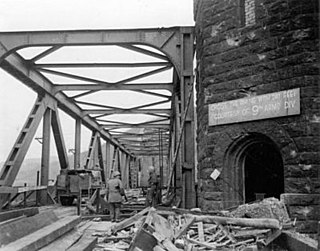
Operation Lumberjack was a military operation with the goal of capturing the west bank of the Rhine River and seizing key German cities, near the end of World War II in Europe. The First United States Army launched the operation in March 1945 to capture strategic cities in Nazi Germany and to give the Allies a foothold along the Rhine.
The 1st Army Corps was first formed before World War I. During World War II it fought in the Campaign for France in 1940, on the Mediterranean islands of Corsica and Elba in 1943 - 1944 and in the campaigns to liberate France in 1944 and invade Germany in 1945.
Charles B. MacDonald was a former Deputy Chief Historian for the United States Army. He wrote several of the Army's official histories of World War II.

XLVII Panzer Corps was a panzer corps of the German Army in World War II that was formerly designated as XLVII Corps. Various formations of the corps fought in the French campaign of 1940, in the invasion of Soviet Union from 1941 to 1944, and on the Western Front from June 1944 until April 1945.
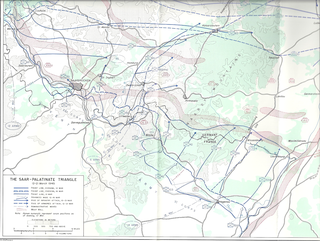
Operation Undertone, also known as the Saar-Palatinate Offensive, was a large assault by the U.S. Seventh, Third, and French First Armies of the Sixth and Twelfth Army Groups as part of the Allied invasion of Germany in March 1945 during World War II.
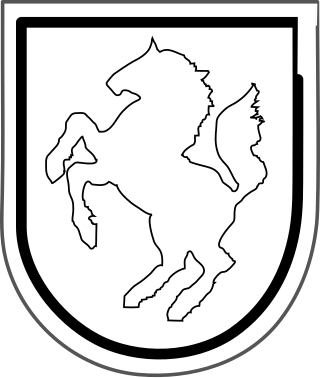
V Army Corps was a corps in the German Army during World War II.
The following units and commanders participated in the Lorraine campaign from September 1 to December 18, 1944.

Major General John Millikin was a senior United States Army officer who served in both World War I and World War II. During the latter, Millikin commanded III Corps in General George S. Patton's U.S. Third Army during the Battle of the Bulge in December 1944.

Operation Flashpoint was the Ninth United States Army part of Operation Plunder, the crossing of the lower Rhine by the 21st Army Group during March 22–28 March 1945, in the last months of World War II, in which the Ninth Army established bridgeheads in the sector between Wesel and Walsum on the right bank of the Rhine.
The 559th Volksgrenadier Division was a volksgrenadier division of the German Army during World War II that fought entirely on the Western Front.














